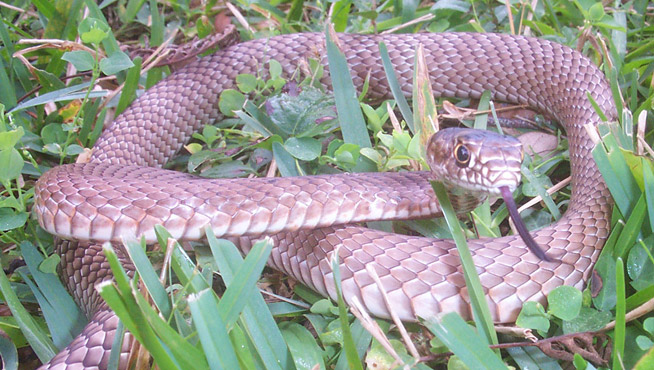Masticophis flagellum
Not Dangerous (Non-poisonous)
Coachwhips do not have venom that is dangerous to most humans.

Why is a snake called the “coachwhip”? The coachwhip snake often resembles the braided lash of an 18th century British coachman’s horsewhip. It is one of the fastest, longest, and most lithe snakes in the North America.
This snake forges on the surface during the day and is often active in hot conditions when other snakes seek shelter in cool retreats. Encounters with this snake are usually brief as it wastes little time disappearing into nearby cover when threatened. It spends most of its time on the ground but it is a capable climber that is occasionally encountered in trees and on cacti. It hibernates during the cold months of late fall and winter.
According to folklore, the coachwhip will pursue and attack a person, squeezing its victim in its coils and lashing him to death with its tail. It will even stick the tip of its tail up a comatose victim’s nose just to make certain that breathing has ceased and life has ended. Otherwise, the snake will resume its lashing. that is false! The best-known myth about these snakes is that the coachwhip will actively chase people and whip them to death. That is also false. The hoop snake legend, where a snake grabs its tail with its jaws and rolls itself like a wheel after prey, possibly refers to coachwhip snakes.
In real life, of course, the coachwhip will not set upon a human, but it will certainly defend itself vigorously if cornered. Generally, the snake will try to elude predators with a sudden burst of speed (up to 4 mph) or by climbing into trees and bushes, or disappearing into the burrows of small mammals. If cornered, these snakes will coil defensively, vibrating the tail in trying to mimic a rattlesnake. If persistently harassed it may feign death by tucking the head down close to the ground and remaining motionless. If cornered, these snakes will coil defensively, vibrating the tail in trying to mimic a rattlesnake. If handled, they will fight fiercely and bite to defend themselves. These non-venomous snakes have needle-sharp teeth which produce lacerations when it bites, rather than punctures like fangs on venomous snake.
It eats a wide variety of animals including lizards, snakes (including rattlesnakes), mice, birds, insects, bats, frogs, toads, and small turtles. It is an impressive predator with a keen eyesight better than most other snakes. The coachwhip snake is often seen with its head raised above the ground looking for prey or on lookout for possible predators.
The coachwhip is a thin-bodied snake with smooth scales, a long and tapered tail, small angular head and proportionally large eyes with round pupils. An adult coachwhip may reach more than 8 feet in length, but the average is about 4 to 6 feet.

The color varies a lot, but it mostly reflects their natural surroundings ensuring a proper camouflage. In western areas their color ranges from dark brown, tan, and yellowish to gray or even pinkish for the Red coachwhip also known as Red racer. Normally the belly is a lighter color, in some cases with cross banding.
Although little is known about the lifespan of the coachwhip in the wild, captive coachwhips have been known to live longer than 16 years.